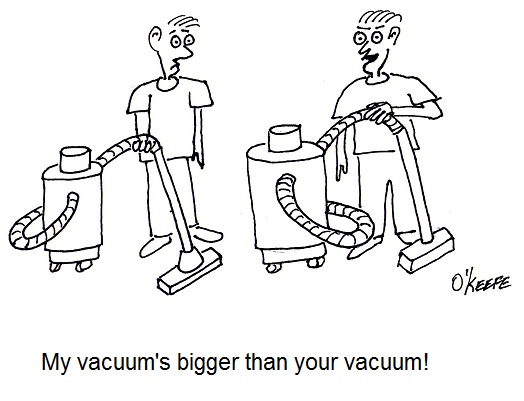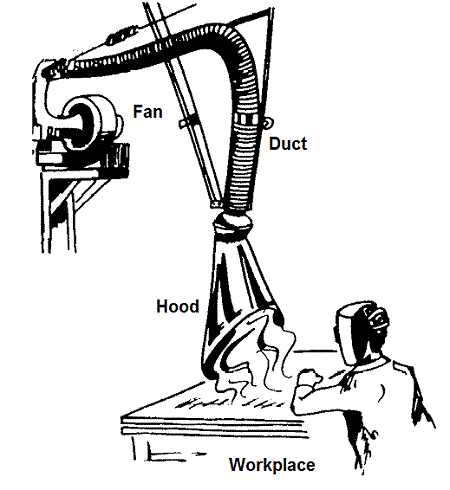| I’m a husband who occasionally does a little vacuuming, at least of the areas I’m responsible for messing up. It’s not one of my favorite activities, and I particularly hate it when I’m in a hurry and I don’t have enough time to move things out of the way. That’s when an accident is prone to happen, and I end up sucking something besides dirt into the hose. The extra work I’ve just created for myself results in my having to open up the vacuum bag and start sifting through the debris. In the end, I sometimes end up making a bigger mess than the one I started out with.
Vacuums are wonderful tools, when used correctly. And when you think about it, the constituent elements of a household canister vacuum cleaner are similar to those of an industrial local exhaust ventilation system. My home vac is comprised of five main elements, all of which most of you are familiar with: a nozzle, hose, filter, a fan located inside the canister to provide suction, and an exhaust hole, also located within the canister, which serves to discharge newly filtered air back into the atmosphere. Industrial usage local exhaust ventilation systems also typically consist of five constituent elements, namely, a hood, ducts, an air cleaning device, a fan, and an exhaust stack. Like my home vacuum its main objective is to suck something in, namely, contaminated air. Let’s take a closer look at each of the parts. The hood is located at the beginning of the local exhaust ventilation system, and like your home vac’s nozzle, it’s positioned in close proximity to the area requiring cleaning. The objective is of course to capture contaminants at the source. Now placement of the hood within the work area is very important. Ultimately it must be far enough away from the source of contamination so as not to interfere with the work that’s being done, yet close enough to prevent contaminants from escaping. Hoods that almost completely enclose the work area provide the best control of contaminants. Trouble is, they can interfere with the work process. That’s where a specific design of hood, known as a “capture exhaust hood” comes in handy. This type of hood is attached to a flexible duct that resembles a super-sized vacuum cleaner hose. This arrangement provides greater flexibility than a huge, all-encompassing hood, and it also allows the hood to be easily positioned anywhere within the workplace as necessary. Again, placement of a capture exhaust hood is critical to its effective operation. Say for instance that a hood is initially positioned a mere two inches from a source of fumes, then someone comes along and bumps it. It ends up being four inches away from the source, and now it will require around three times the amount of air volume through the system to provide the same degree of capture as it did when it was just two inches away. If the ventilation system isn’t strong enough to draw in this extra volume of air, fumes will escape into the work area, rendering our cleanup efforts ineffective. Next time we’ll discuss the second main component in a local exhaust ventilation system, its ductwork. _____________________________________________ |
Posts Tagged ‘toxic fumes’
Industrial Ventilation – Local Exhaust Ventilation Hoods
Sunday, April 17th, 2011Industrial Ventilation – Local Exhaust Ventilation
Sunday, April 10th, 2011| My wife often says I’m the worst cook she knows. This doesn’t really bother me too much, because she’s the best cook I know, and she keeps me well fed. But there are times that I have to fend for myself in the kitchen, and this sometimes results in a foul smelling mess plastered all over the stove. Lucky for me we have a nice exhaust hood, and it usually manages to suck out the odor before my wife gets home.
Local exhaust ventilation systems, like the vent over my stove, work much the same way in an industrial setting, albeit on a larger scale. This type of ventilation system gets its name because its action is quite specific, localized to contain exhaust air from a particular area. They’re routinely placed as close as possible to the source of contaminants, and they are able to work quickly to capture and expel chemical vapors, dusts, and fumes, before they spread. This type of ventilation is effective for other reasons, too, because it helps keep down heating and cooling costs. Instead of treating an entire building for ventilation issues, the problem can be nipped in the bud at its source. In many situations, local exhaust ventilation is preferred over dilution ventilation systems for these very reasons. A basic local exhaust ventilation system is comprised of a duct, a fan, and a hood as shown in Figure 1 below. One end of the duct is attached to the intake of the fan. The other end of the duct is attached to the hood. The duct can be rigid or flexible. The hood is positioned in the workplace near the source of contaminants. Figure 1 – Basic Local Exhaust Ventilation System This local exhaust ventilation system operates by much the same principle as the one generally governing the movement of liquids and gases. If you’re a regular reader of this blog, you’ll remember me writing that liquids and gases always flow from areas of higher pressure to those of lower pressure. Well, the air within the room has pressure principles at play as well, and the air within a given work area is at atmospheric pressure. When the fan is introduced into the scenario, a vortex is created within the duct which is less than that of the atmospheric pressure in the room. This difference in pressures causes the room air to flow into the ventilation duct along with its contaminants. The room air and contaminants flow out through the ventilation system, where they are then exhausted outside of the building. But because room air is being drawn into the ventilation system, provisions must be made to supply enough replacement air. Without the proper ratio of air moving in to that moving out, a ventilation system will not work properly. In other words, the suction created by the local ventilation system could cause the pressure in the room to drop below atmospheric pressure. This could cause the higher atmospheric pressure outside the room to bear down on doors, making them difficult to open. Worse yet, contaminants could back up into the room, causing workers to get sick. Now that we’ve covered the basics of local exhaust ventilation, we can move on to its five constituent elements and a discussion of their design. We’ll do that next week. _____________________________________________ |
Industrial Ventilation
Sunday, March 27th, 2011| On a hot, sticky day, what price would you pay for a cool breeze? Imagine for a moment that it’s 90 degrees in the shade and humidity is 85%. There are few human beings that wouldn’t consider this uncomfortable weather, although I have some die hard neighbors who rarely close their windows during the summer to engage the air conditioning, a rather recent modern convenience. My mom told me stories of how it was common in the 1940s for entire Chicago neighborhoods to head to Lake Michigan, spread a blanket, and sleep on the beach to keep cool on the hottest nights. As for myself, I remember being really happy when Dad broke down and finally purchased a window air unit. It was as big as a small refrigerator and took two men to lift. It was loud and drew so much power it frequently “blew the fuse.” It was so much nicer when central air conditioning came along a few years later and we could finally retire that old clunker.
Ultimately, it’s ventilation that makes air conditioning work, the principle here being a continuous circulation of air, exchanging hot for cooled. If you’ll remember, hot air gives up its heat to coils containing coolant, and the newly cooled air is released back into the room. In addition to cooling, another major function of ventilation is to remove odors and refresh the air. Everyone likes a fresh smelling home, but even more importantly, proper ventilation reduces the concentration of contaminants in the air, things which tend to make us sick, like mold. That’s why many states’ building codes require whole house air ventilation systems to be installed in new homes. In industrial settings ventilation performs the same functions, but it’s necessary for other reasons as well. Industrial facilities often house processes that create airborne toxins and other contaminants. These byproducts of manufacturing can be dangerous if allowed to collect unchecked within the confines of a building. Air containing certain concentrations of contaminants, such as vapors emitted by paints and solvents, can ignite, resulting in fire or explosion. For safety of both workers and equipment, fresh air must displace air contaminated with fumes and dust. There are three types of ventilation that can be found in industrial facilities. These include indoor air quality ventilation, dilution ventilation, and local exhaust ventilation. Indoor air quality ventilation provides freshly heated or cooled air to buildings as part of the normal heating, ventilating and air conditioning system, much like we have in our own homes. Dilution ventilation gets its name from the fact that it dilutes contaminated air by displacement, the blowing in of clean air and exhausting of dirty. The last type of ventilation, local exhaust ventilation, captures contaminated emissions at or near the source and exhausts them directly outside. Depending on the type of industrial application one, two, or all three of these ventilation types may be employed to keep air quality safe. Next week we’ll discuss dilution ventilation in detail, followed by local exhaust ventilation, and we’ll gain a better understanding of how they are used to protect worker health and safeguard property. _____________________________________________ |





